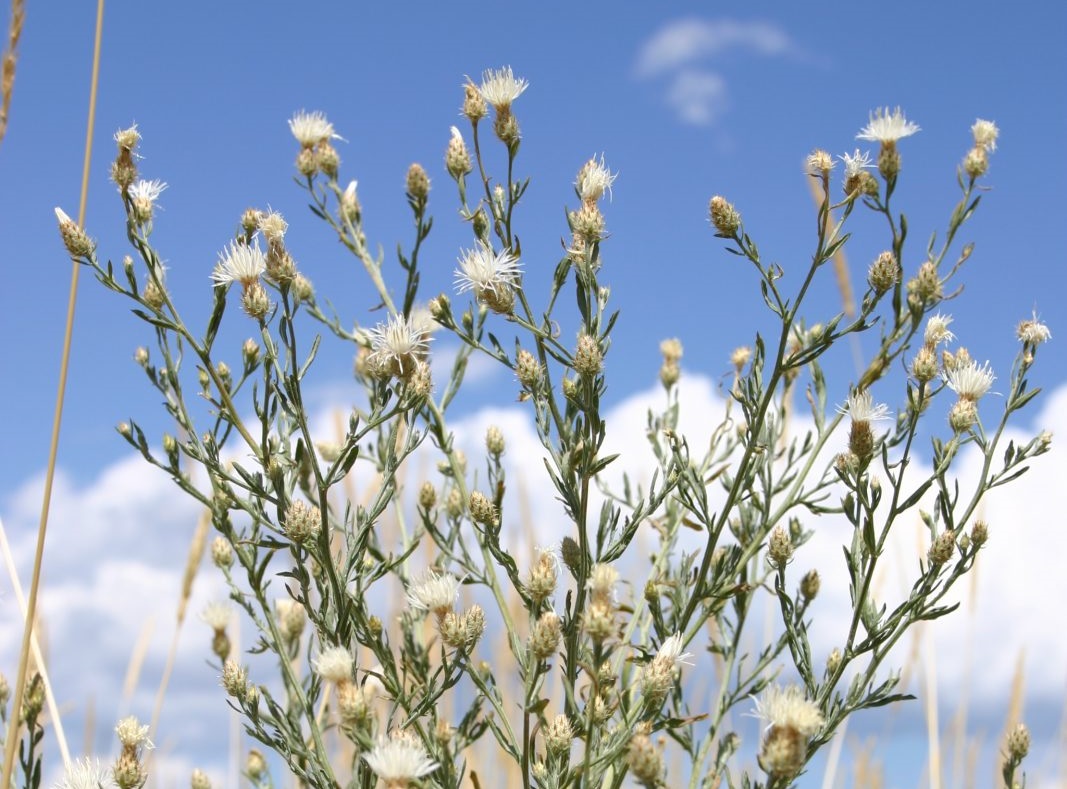Range and Pasture Weed of the Week – Knapweed, Spotted and Diffuse

This article is a summary of Nebraska Extension Circular EC 173, Noxious Weeds of Nebraska Spotted and Diffuse Knapweed and the Extension Circular EC130, 2021 Guide for Weed, Disease, and Insect Management in Nebraska.
Spotted knapweed and diffuse knapweed are two of Nebraska’s eleven noxious weeds. They are a closely related species that are well adapted to a variety of habitats including roadsides, ditch banks, pastures, rangelands, open forests and waste areas. They are found throughout the state, but are primarily concentrated in the northern Panhandle counties.
The knapweeds were introduced to America from the grasslands of southeastern Europe and Asia, and likely came to the United States as contaminates with alfalfa. Spotted and diffuse knapweed reduce grazing land productivity and wildlife habitat by outcompeting and displacing native species, causing a change in plant community structure and increasing surface runoff. Knapweeds produce chemicals that are undesirable to livestock and also can have an allelopathic effect, inhibiting the growth of native plants.
Biology of Knapweeds
Spotted and diffuse knapweeds are most often biennials or short-lived perennials that reproduce by seeds that germinate in the fall or early spring when moisture and temperatures are suitable. Seedlings develop into a deep tap-rooted rosette, which then put most of their energy into producing roots. Occasionally they act as an annual by germinating in spring and maturing into seed-producing adults in one year. If the plant doesn’t bolt, it will overwinter and develop a new rosette the next year.
Plants tend to bolt in early June, flower from July through September, and typically produce seeds by the middle of August. Knapweed seed is spread with infested hay or when the mature plant breaks off at the root stock and is blown in the wind or are caught and dragged by vehicles. Seeds can remain viable in the soil for more than seven years.
Identification of Knapweeds


The initial leaves growing from the rosette stage of both knapweeds occur on short stalks and can grow up to 8 inches long and 2 inches wide. The flower head of both knapweeds is shaped like a miniature vase that is approximately 0.25 inches wide by 0.5 inches long and remains on the plant after maturity.
Spotted knapweed flowers (Fig. 1) spread out from the top of the flower head with purple to pink or rarely white petals. Both spotted and diffuse knapweed flower heads are wrapped in yellow-green to brown bracts (leaf-like structures) that are marked with fine vertical streaks. Spotted knapweed bracts are tipped with a black comb like fringe that gives the flower head a “spotted” appearance. Diffuse knapweed flower petals (Fig. 2) are mostly white but occasionally are rose to lavender colored. Diffuse knapweed bracts are brownish-yellow or brown at the tips, but not usually black.
Control Methods
The most cost-effective method for knapweeds is early identification and prevention from spreading. Cultural management practices that encourage a healthy plant community of desired plants are foundational to resist invasion by knapweed. Once knapweed infestations are present, an integrated approach of cultural, mechanical, biological and chemical control methods is likely the best approach.
On range and pasture, persistent careful hand pulling can be used on single plants or small infestations. Care must be used when pulling as soil disturbance may increase susceptibility of the site for reinvasion. Mowing during the late bud stage of development will reduce seed production and can remove old dead growth which can help improve herbicide contact to leaves of growing plants. Knapweed should not be mowed once the plant has set seed, as this can disperse seeds.
Chemical control of established populations of spotted and diffused knapweed is expensive and eradication may be impossible. That is why early detection and rapid response to new small infestations is so important to prevent further invasion. The Extension Circular EC130, 2021 Guide for Weed, Disease, and Insect Management in Nebraska has several chemical product recommendations that can be effective. Always read and follow label directions before applying herbicides.
Biological control of knapweed utilizing grazing and natural enemies can be helpful in reducing infestations. Livestock will graze knapweed to some degree. Controlled repeated grazing of knapweed by sheep and goats during the early spring at the rosette stage and again in the bud stage can reduce plant vigor, density, size, flower stems, and seed production. Natural enemies from Eurasia have been introduced into North America for biological control. Seedhead weevils and root boring weevils attack knapweed flower heads and also attack the roots. In some locations in other states, the introduction of these natural predators has significantly reduced knapweed populations. It should be noted that the introduction of these insects will not eliminate knapweed, but is used as a tool to reduce its prevalence in sites where it is widely established.
A combination of timed, targeted grazing with release of biological control insects over several years has been shown to significantly reduce knapweed density on rangeland. A combination of multiple biological control methods will likely provide the most effective long-term control of spotted and diffuse knapweed where significant infestations have occurred and eradication is no longer a cost effective option.
Interviews with the authors of BeefWatch newsletter articles become available throughout the month of publication and are accessible at https://go.unl.edu/podcast.
